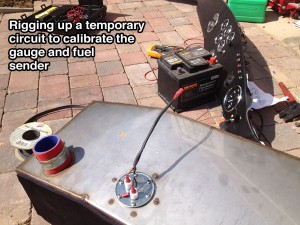Next job of the day was to do the final fit of the fuel tank. The fuel tank had been in and out a few times and we had a few attempts to find the perfect position for it, but now we were ready to get it in for good. We took a little time fitting the level sender unit. The sender comes with an adjustable float arm that needs to be set to the right length and Mark had sorted this little job out previously. Basically the arm is made of two lengths of wire clipped together, one is connected to the sender and one has a bent end that clips to the float. To get the correct length Mark first measured the depth of the tank, then measured the length of the arm with the float in the fully empty position. He adjusted the length of the arm so that when fitted and in the empty position the float would hover just above the bottom of the tank. Once we were confident it was correct, he then soldered together the two wires to prevent them later coming apart at the bottom of the fuel tank.
You can refer to our previous post about preparing the fuel tank and sender here
Next, with the wiring instructions to hand Mark rigged up a temporary circuit to connect the fuel gauge, voltage stabiliser and sender unit via the battery. This was in order to calibrate the gauge and make sure it correctly read full and empty in relation to the movement of the float and sender. Once we had established this was all working correctly we then fitted the sender with 6 screws and fitted the tank in place using brackets that bolts through the boot floor and the rear bulk head. This time we decided to nyloc all the nuts.


Once the tank was in we could then do the final fit of the fuel filler cap. We had done this previously but this time we fitted the rubber fuel pipe and secured it with 2 jubilee clips to seal it between the neck of the tank and the underneath of the filler cap flange. We had decided to modify the filler cap assembly back in January, by wielding the 2 bottom sections together. This made it slightly more fiddly to get the nuts and bolts in, nevertheless we think it was a worthwhile modification to halt any potential for fuel leaks in the future.


Leave A Comment